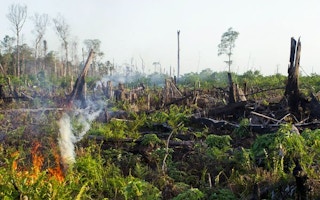Half the fire hotspots that are causing the severe haze in Singapore and Malaysia are in areas that should be protected by Indonesia’s forest moratorium, said Greenpeace International on Thursday.
The environmental NGO said in a statement that half the hotspots detected between June 11 to 18 are in areas meant to be protected.
This information comes after Indonesia’s President Susilo Bambang Yudhoyono extended the country’s forest moratorium last month, which aims to prevent new clearing of primary forests and peat lands for another two years.
In 2011, he had imposed a two-year moratorium on forest-clearing concessions under a $1 billion agreement with the Norwegian government, meant to support a UN programme to reduce emissions from deforestation and forest degradation known as REDD.
Forest Campaigner for Greenpeace Southeast Asia, Yuyun Indradi, said: “The fact these fires continue to affect the region shows just how poorly forest protection measures are enforced in Indonesia. But corporations must also take responsibility for their supply chains, commit to zero deforestation and stop the sort of illegal practices such as fire clearing that is destroying our forests and clogging our air.”
More than 10 million hectares of primary forests and around 32 million hectares of secondary forests still do not have any legal protection in Indonesia, according to Greenpeace International’s analysis of the government’s recent revision of its moratorium map (PIPIB) data.
“With each revision, the amount of forest legally protected under the moratorium is reduced – more than six million hectares has been lost since 2011. President SBY recently told Greenpeace he will do more to strengthen environmental protection, but the reduction in protected forest signals a weakening rather than a strengthening of forest protection,” Yuyun said.
More than 600,000 hectares of peatland and primary and secondary forest – rich carbon stores that if destroyed would contribute greatly to Indonesia’s massive greenhouse gas emissions – have been excluded from the latest moratorium map, said Greenpeace.
The lack of updated data and transparency creates confusion around what forest is actually protected under the moratorium. Based on best available data, the forest moratorium overlaps with 5.5 million hectares that have been granted as concession areas for development to pulp wood or oil palm plantations, selective logging or mining.
The government must review existing concessions, increase transparency in the way licenses are granted, establish a credible database of low carbon land as an alternative to the current destruction of high carbon land and undertake clear spatial and land use planning, it added.
Singapore and Indonesia have been at a war of words ever since haze from the fires in Sumatra was brought over by prevailing winds blowing from the southwest or west since last Thursday.
The Pollutant Standards Index (PSI), which measures air quality, hit a record high of 371 in Singapore on Thursday at 1pm, and has dropped to 253 by 4pm.
Singapore has called on Indonesia to do more to prevent the fires and punish the companies behind them, while Indonesia said Singapore-based companies could be behind the hotspots.
Both governments said they will take action against companies that are responsible for the fires in Sumatra.

















